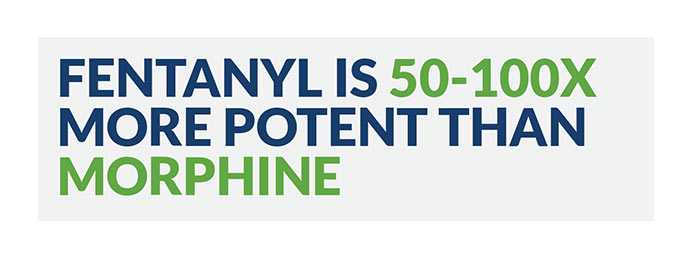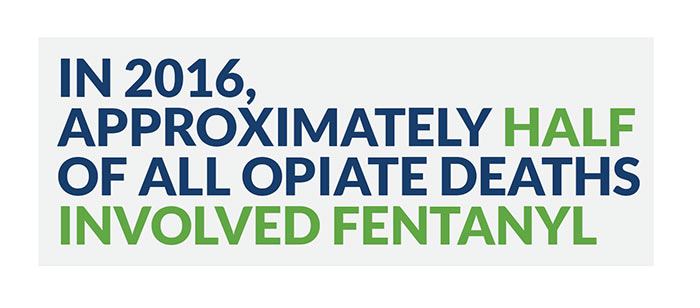Fentanyl Treatment and Rehab
Fentanyl is a synthetic opiate analgesic considered 50-100 times more potent than morphine. The drug was first synthesized in the early 1960s by Belgian chemist Paul Janssen, later exploding on the global marketplace due to its efficacy in post-surgical pain management.
Considered a Schedule 11 Substance by the Drug Enforcement Administration (DEA) with a high potential for addiction, fentanyl continues to be prescribed for legitimate medical purposes, although its abuse in recent years has skyrocketed and illicit manufacturing and distribution practices have surged to epidemic proportions.
A spate of celebrity deaths including Prince has helped gradually increase awareness of fentanyl’s inherent dangers; however, it is still a major public health threat and enemy. According to the Centers for Disease Control and Prevention (CDC), in 2016, approximately half of all opiate deaths involved fentanyl, exceeding the death toll of prescription opiates or heroin.
THE FENTANYL PATCH

HOW REHAB HELPS
The powerful, unpredictable effects of fentanyl demand intensive professional treatment. Once addicted, users cannot afford the risks associated with casual self-guided therapy or at-home detox.
To understand the necessity of professional treatment, one must first consider how fentanyl works. Like other natural and synthetic opiates, fentanyl binds to opiate receptors located in the brain and central nervous system (CNS). This binding process rapidly alters the perception of pleasure and pain, which it achieves through the mechanism of artificially increasing dopamine— a major neurotransmitter. Although the initial euphoria associated with this state is highly desirable, it is short-lived and carries with it potentially fatal long-term risks.

- Muscle spasms
- Headache
- Profuse sweating
- Insomnia
- Tremors
- Vomiting
- Extreme restlessness
- Diarrhea
- Loss of appetite
- Disorientation
- Coma
- Sudden death
Fentanyl withdrawal symptoms may appear in as few as three or four hours following dosage, with the most severe symptoms peaking within one to two weeks in most cases. During this critical period, a professional rehab program can help stabilize a user and safely administer evidence-based pharmacological and therapeutic interventions designed to minimize discomfort and eliminate unnecessary risks.
Post-acute withdrawal symptoms (PAWS) are another aspect of fentanyl detox that requires professional management. Although this protracted withdrawal process usually fades within months, it can linger for years and, in some cases, last permanently depending upon the extent of physical and neurological damage.
Fentanyl treatment and rehabilitation is a complex, high involved process geared toward gradually rebuilding psychological and physiological health. Like other hard-core opiates, fentanyl depletes vital nutrient reserves and alters brain structure and function, making it difficult for chronic users to function independently and responsibly. Although certain aspects of the fentanyl-damaged brain may remain unchanged with treatment—for example, the loss of gray matter or damaged neural pathways—many can be gradually rebuilt or improved with the right combination of medical and behavioral therapy. The human brain contains a miraculous, innate capacity to remodel itself over time, a process called neuroplasticity. Fortunately, neuroplasticity allows for significant improvement in even the most extreme fentanyl user— provided they adhere to treatment protocol and, most importantly, discontinue use.
TREATMENT OPTIONS
Fentanyl treatment is available in a wide variety of options, all of which are appropriate for users in different stages of the addiction and withdrawal process. These include:
- Intensive inpatient treatment – This popular treatment protocol involves clients living at a designated residential facility, usually for a period of one to three months. During a client’s stay, a combination of pharmacological and psychotherapy is utilized. The 24/7 staff monitoring and safe, supportive environment offered by such facilities are generally regarded as the industry gold standard and provide optimal social and therapeutic benefit to fentanyl users who require a premium level of care.
- Intensive outpatient treatment (IOP) – This less intensive treatment protocol involves clients attending a designated treatment facility on a non-residential basis, usually for sessions three to five times per week. During the course of IOP, clients are also administered various pharmacological interventions and participate in group and individual therapy. Although IOP programs boast many benefits and are convenient for those with demanding personal or professional schedules, they are not considered optimal when dealing with an opiate as potent and debilitating as fentanyl.
- Outpatient treatment (OP) – This least intensive protocol involves clients attending a casual, once or twice a week schedule of individual and/or group therapy in addition to occasional medical follow-up and consultation. OP treatment is never recommended as a first intervention for fentanyl users, although it is appropriate as a progressive stage in continuing care upon successful completion of an intensive inpatient or IOP treatment program.
MEDICATION-ASSISTED TREATMENT
Medication-assisted treatment (MAT) is a crucial aspect of intensive inpatient treatment that incorporates Food and Drug Administration-approved medications in combination with psychotherapy. Fentanyl addiction is safely and effectively treated by the following, evidence-based pharmacological interventions that form the core of MAT— in addition to whatever medications are incorporated into the regimen to treat co-occurring disorders such as anxiety and depression:
- Suboxone – Used early in symptom onset, this combination of buprenorphine and naloxone (an opiate antagonist) is frequently used to help prevent intravenous buprenorphine abuse. This clinically proven medication for opiate dependence significantly lowers the risk of precipitated withdrawal. Suboxone activates the same neurological receptors as fentanyl and is generally well-tolerated.
- Clonodine – Classified as an anti-hypertensive, this increasingly popular medicine helps curb the symptoms associated with fentanyl withdrawal. Clonidine works by blocking brain chemicals that activate the sympathetic nervous system (SNS).
- Vivitrol – An injectable prescription variety of naltrexone that helps control cravings and stabilize psychological and physiological processes. The drug is available in both pill and once-per-month injectable form and works by blocking opiate receptors in the brain, noticeably diminishing the euphoric effects associated with fentanyl.
In addition to these MATs, the following evidence-based therapies are incorporated into the administration of a MAT:
- Cognitive behavioral therapy (CBT) – This popular, short-term, goal-oriented psychosocial intervention is geared toward changing deeply entrenched patterns of thought and behavior. CBT is empirically proven to be highly successful in treating fentanyl addiction.
- Dialectical behavioral therapy (DBT) – A type of cognitive psychotherapy, DBT is used to identify and overcome problematic behaviors utilizing intensive individual psychotherapy and group skills. DBT has been deemed particularly effective when used to treat borderline personality disorder and other client-specific psychological disorders.
- Motivational interviewing (MI) – a directive, client-centered therapeutic approach that helps clients to identify, confront and resolve emotional ambivalence.
- Creative and Expressive therapy – holistic, spiritually focused therapies designed to help clients overcome inhibitions, explore unresolved pain and trauma, and find enjoyment in the recovery process.
- Family therapy – a therapeutic intervention used to help identify blocks in communication, resolve dysfunctional patterns, and encourage clear, healthy dialogue within the family unit. It can be extremely effective when combined with other therapeutic modalities.
TAKING THE NEXT STEP
If you or someone you love is struggling with fentanyl addiction, consult a substance abuse professional today. Fentanyl is a killer that knows no social, professional, economic, religious, or racial boundaries. It can affect anyone, at any time, regardless of whether or not there is a known genetic proclivity for addiction or history of prior use. Also remember, fentanyl overdose is a medical emergency requiring immediate treatment at a hospital emergency room. Don’t delay, act now!
For more about fentanyl addiction and recovery, check out these related articles:
- Common Co-occurring Disorders Associated with Addiction
- 10 Questions to Ask When Choosing a Treatment Center
- Fentanyl Addiction: Signs and Symptoms of Fentanyl Abuse
- Motivating Someone to Seek Help for a Drug or Alcohol Problem
Sources:
Journal of Medical Toxicology. Transdermal fentanyl: pharmacology and toxicology. Dec, 2009.
Journal of Pain and Symptom Management (JPSM). Is Fentanyl Patch End-Of-Dose Failure Associated with Body Mass Index? Feb, 2018.
The New England Journal of Medicine. Addressing the Fentanyl Threat to Public Health. Feb, 2016.
The American Journal of Emergency Medicine. Fentanyl-laced heroin: a report from an unexpected place. Feb, 2009.

